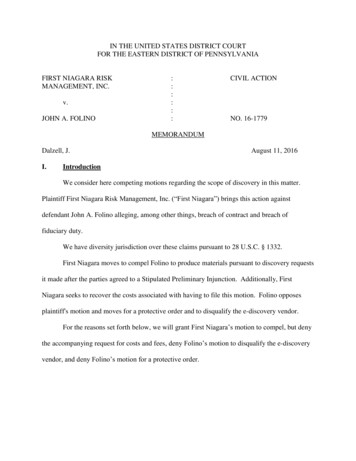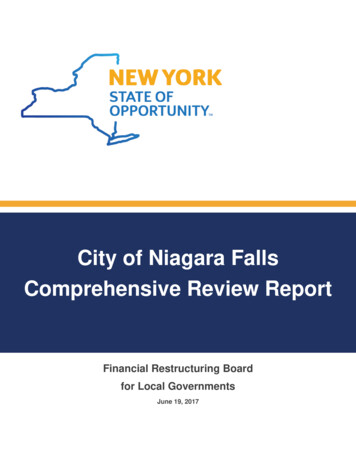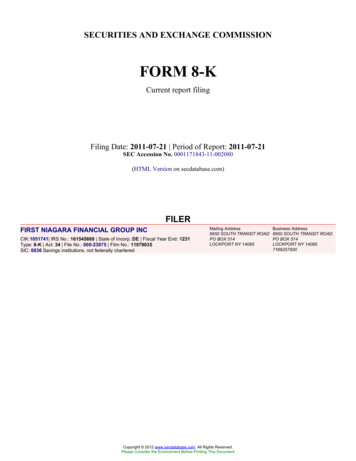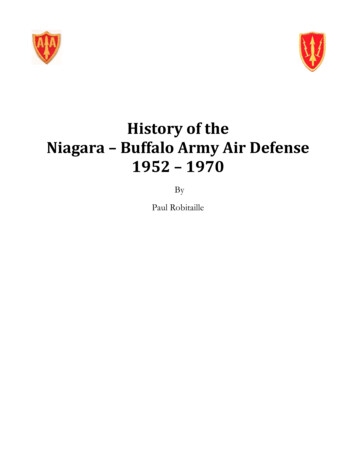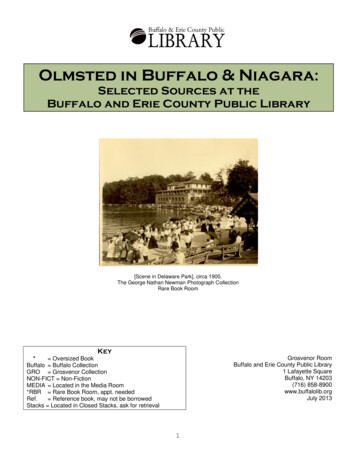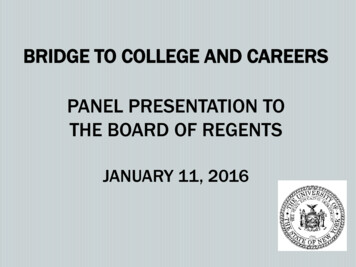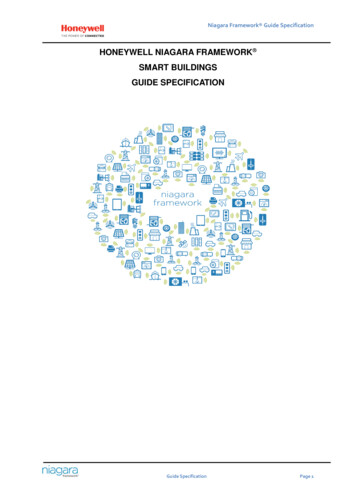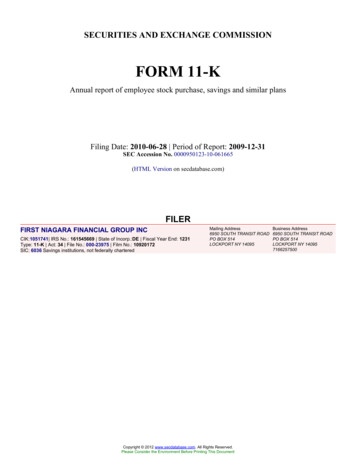
Transcription
SECURITIES AND EXCHANGE COMMISSIONFORM 11-KAnnual report of employee stock purchase, savings and similar plansFiling Date: 2010-06-28 Period of Report: 2009-12-31SEC Accession No. 0000950123-10-061665(HTML Version on secdatabase.com)FILERFIRST NIAGARA FINANCIAL GROUP INCCIK:1051741 IRS No.: 161545669 State of Incorp.:DE Fiscal Year End: 1231Type: 11-K Act: 34 File No.: 000-23975 Film No.: 10920172SIC: 6036 Savings institutions, not federally charteredMailing Address6950 SOUTH TRANSIT ROADPO BOX 514LOCKPORT NY 14095Copyright 2012 www.secdatabase.com. All Rights Reserved.Please Consider the Environment Before Printing This DocumentBusiness Address6950 SOUTH TRANSIT ROADPO BOX 514LOCKPORT NY 140957166257500
UNITED STATESSECURITIES AND EXCHANGE COMMISSIONWashington, D.C. 20549FORM 11-KANNUAL REPORT PURSUANT TO SECTION 15(d) OF THE SECURITIESEXCHANGE ACT OF 1934þFor the fiscal year ended December 31, 2009ORTRANSITION REPORT PURSUANT TO SECTION 15(d) OF THE SECURITIESEXCHANGE ACT OF 1934oCommission file number 000-23975A.FULL TITLE OF THE PLAN AND THE ADDRESS OF THE PLAN, IF DIFFERENT FROM THAT OF THEISSUER NAMED BELOW:First Niagara Financial Group 401(k) PlanB.NAME OF THE ISSUER OF THE SECURITIES HELD PURSUANT TO THE PLAN AND THE ADDRESS OFITS PRINCIPAL EXECUTIVE OFFICE:First Niagara Financial Group, Inc.726 Exchange StreetSuite 618Buffalo, New York 14210REQUIRED INFORMATIONThe First Niagara Financial Group 401(k) Plan (the Plan ) is subject to ERISA and therefore is filing thefinancial statements and schedule prepared in accordance with the financial reporting requirements of ERISA,as of and for the years ended December 31, 2009 and 2008, as an exhibit to this report. Such Plan financialstatements and schedule include Reports of Independent Registered Public Accounting Firms thereon.EXHIBIT INDEX23.1Consent of Independent Registered Public Accounting Firm99First Niagara Financial Group 401(k) Plan Financial Statements and Schedule as of and for theyears ended December 31, 2009 and 2008, with Reports of Independent Registered PublicAccounting Firm thereon.SIGNATURESPursuant to the requirements of the Securities Exchange Act of 1934, the Compensation Committee of theBoard of Directors of First Niagara Financial Group, Inc. (as administrator of the Plan) has duly caused thisannual report to be signed on its behalf by the undersigned hereunto duly authorized.Date: June 28, 2010By: /s/ Julie LaForestFirst Vice President Benefits & Operations ManagerFirst Niagara Financial Group, Inc.Copyright 2012 www.secdatabase.com. All Rights Reserved.Please Consider the Environment Before Printing This Document
Copyright 2012 www.secdatabase.com. All Rights Reserved.Please Consider the Environment Before Printing This Document
Exhibit 23.1CONSENT OF INDEPENDENT REGISTERED PUBLIC ACCOUNTING FIRMThe Qualified Retirement Plans Committee ofFirst Niagara Financial Group, Inc.:We consent to the incorporation by reference in the Registration Statement (File No. 333-105525) on Form S-8 of FirstNiagara Financial Group 401(k) Plan of our report dated June 24, 2010, with respect to the statements of net assetsavailable for benefits of First Niagara Financial Group 401(k) Plan as of December 31, 2009 and 2008, the relatedstatements of changes in net assets available for benefits for the years then ended, and the related supplementalschedule of assets (held at year end) as of December 31, 2009, which report appears in the December 31, 2009annual report on Form 11-K of First Niagara Financial Group 401(k) Plan.Bonadio & Co., LLPJune 24, 2010Williamsville, NYCopyright 2012 www.secdatabase.com. All Rights Reserved.Please Consider the Environment Before Printing This Document
Exhibit 99FIRST NIAGARA FINANCIAL GROUP401(k) PLANFinancial Statements as ofDecember 31, 2009 and 2008AndSupplemental ScheduleTogether withReport of Independent RegisteredPublic Accounting FirmCopyright 2012 www.secdatabase.com. All Rights Reserved.Please Consider the Environment Before Printing This Document
REPORT OF INDEPENDENT REGISTERED PUBLIC ACCOUNTING FIRMThe Qualified Retirement Plans Committee ofFirst Niagara Financial Group, Inc.:We have audited the accompanying statements of net assets available for benefits of the First Niagara FinancialGroup 401(k) Plan (the Plan) as of December 31, 2009 and 2008, and the related statements of changes in netassets available for benefits for the years then ended. These financial statements are the responsibility of the Plan smanagement. Our responsibility is to express an opinion on these financial statements based on our audits.We conducted our audits in accordance with auditing standards of the Public Company Accounting Oversight Board(United States). Those standards require that we plan and perform the audit to obtain reasonable assurance aboutwhether the financial statements are free of material misstatement. An audit includes examining, on a test basis,evidence supporting the amounts and disclosures in the financial statements. An audit also includes assessing theaccounting principles used and significant estimates made by management, as well as evaluating the overall financialstatement presentation. We believe that our audits provide a reasonable basis for our opinion.In our opinion, the financial statements referred to above present fairly, in all material respects, the net assets availablefor benefits of the Plan as of December 31, 2009 and 2008, and the changes in net assets available for benefits forthe year ended December 31, 2009, in conformity with accounting principles generally accepted in the United States.Our audits were performed for the purpose of forming an opinion on the basic financial statements taken as a whole.The accompanying supplemental Schedule of Assets (Held at End of Year) as of December 31, 2009 is presented forthe purpose of additional analysis and is not a required part of the basic financial statements but is supplementaryinformation required by the Department of Labor s Rules and Regulations for Reporting and Disclosure under theEmployee Retirement Income Security Act of 1974. This supplemental schedule is the responsibility of the Plan smanagement. The supplemental schedule has been subjected to the auditing procedures applied in our audit of thebasic financial statements and, in our opinion, is fairly stated in all material respects in relation to the basic financialstatements taken as a whole.Bonadio & Co., LLPJune 24, 2010Williamsville, NYCopyright 2012 www.secdatabase.com. All Rights Reserved.Please Consider the Environment Before Printing This Document
FIRST NIAGARA FINANCIAL GROUP 401(k) PLANSTATEMENTS OF NET ASSETS AVAILABLE FOR BENEFITSDECEMBER 31, 2009 AND 200820092008 72,473,70827,103,0924,813,7712,667,5203,027,983 ETSInvestments, at fair value:Mutual fundsFirst Niagara Financial Group, Inc. common stockCommon/collective trust fundParticipant loansMoney market accountTotal er contribution receivableEmployee contribution receivableOther receivables 7,559380125,571208,709 Total receivables7,939334,280NET ASSETS AVAILABLE FOR BENEFITS AT FAIR VALUEAdjustment from fair value to contract value for interest in common/collectivetrust fund relating to fully benefit-responsive investment contractsNET ASSETS AVAILABLE FOR BENEFITS 110,094,013(22,693 110,071,320The accompanying notes are an integral part of these statements.1Copyright 2012 www.secdatabase.com. All Rights Reserved.Please Consider the Environment Before Printing This Document 88,506,363)(11,977 88,494,386)
FIRST NIAGARA FINANCIAL GROUP 401(k) PLANSTATEMENTS OF CHANGES IN NET ASSETS AVAILABLE FOR BENEFITSFOR THE YEARS ENDED DECEMBER 31, 2009 AND 20082009ADDITIONSEmployee contributionsEmployer contributionsRollover contributionsInterest and dividend incomeNet appreciation (depreciation) in fair value of investments, including realizedgains and losses on sales 7,445,1384,284,4733,442,3062,358,5352008 ,339)25,579,225(3,052,544 )3,874,645127,6467,966,18143,643Total deductions4,002,2918,009,824Net increase 54 110,071,320 88,494,386Total additionsDEDUCTIONSDistributions to participantsAdministrative expensesNET ASSETS AVAILABLE FOR BENEFITS beginning of yearNET ASSETS AVAILABLE FOR BENEFITS end of yearThe accompanying notes are an integral part of these statements.2Copyright 2012 www.secdatabase.com. All Rights Reserved.Please Consider the Environment Before Printing This Document
FIRST NIAGARA FINANCIAL GROUP 401(k) PLANNOTES TO FINANCIAL STATEMENTSDECEMBER 31, 2009 AND 20081.DESCRIPTION OF PLANThe following description of the First Niagara Financial Group 401(k) Plan (the Plan) provides only generalinformation. Participants should refer to the Plan document for a more complete description of the Plan sprovisions.GeneralThe plan is a defined contribution plan with salary reduction features as permitted under Section 401(k) of theInternal Revenue Code. The Plan is funded by employee and employer contributions and covers substantially alleligible employees of First Niagara Bank and its Subsidiaries, which is owned by First Niagara Financial Group,Inc. (FNFG) (collectively, the Company). It is intended to conform with the provisions of the Employee RetirementIncome Security Act of 1974 (ERISA) and subsequent legislation, when applicable.Effective January 1, 2009, the assets of the Plan were transferred to and are maintained by Charles Schwab TrustCompany, (Schwab) as Trustee and Milliman, Inc as recordkeeper for the Plan. At December 31, 2008, the assetsof the Plan were maintained by First Niagara Bank as Trustee and Fidelity Brokerage Services, LLC (Fidelity) ascustodian, and First Niagara Risk Management d/b/a First Niagara Benefits Consulting was the recordkeeper forthe Plan. First Niagara Risk Management is a subsidiary of First Niagara Bank.In September 2009, the Company acquired 57 branch locations in Western Pennsylvania from National City Bank(NatCity). In accordance with the Plan, upon completion of the acquisition, former NatCity employees retained bythe Company were eligible to participate in the Plan and were credited for their years of service with NatCity.Broker commissions associated with investment transactions and investment management fees are paid by thePlan. Administrative fees not paid by the Plan are paid by the Company.EligibilityAll employees who have completed three months of service, as defined in the Plan, have attained the age of 21and who are not represented by a collective bargaining unit are eligible to participate in the Plan.ContributionsEmployees who are eligible to participate in the Plan may elect to contribute up to 100% of their annualcompensation, as defined in the Plan, subject to the annual limitations provided by the Internal Revenue Code.Employees who are age 50 or older by the end of the calendar year are allowed to make an additional catch-up contribution. This contribution was limited to 5,500 and 5,000 in 2009 and 2008, respectively. The catch-up contribution is not subject to the employer matching contribution.Effective January 1, 2009, safe harbor provisions were adopted by the Plan, for which eligible participants shallbe allocated a safe harbor match in an amount equal to 100% of the first 4% of compensation plus 50% of thenext 2% of compensation deferred by a participant, up to a total of 5% of compensation.3Copyright 2012 www.secdatabase.com. All Rights Reserved.Please Consider the Environment Before Printing This Document
1.DESCRIPTION OF PLAN (Continued)Contributions (Continued)Prior to January 1, 2009, the Company contributed a matching contribution to those participating employees whohave elected to make employee contributions. The matching contribution is equal to 100% of an employee scontribution up to 2% of the employee s compensation (as defined in the Plan), plus 75% of an employee scontribution between 2% and 6% of the employee s compensation. Matching contributions for an employee shallnot be more than 5% of the employee s compensation in a Plan year.The Company may also make an annual discretionary contribution to the Plan. No discretionary contributionswere made to the Plan during 2009 and 2008. Participants may also rollover amounts representing distributionsfrom other qualified defined benefit or defined contribution plans.Participants direct the investment of their contributions into various investment options offered by the Plan.Participants may change their investment allocation on a daily basis.Participant AccountsEach participant s account is credited with the participant s contribution and an allocation of (a) the Company scontributions, (b) Plan earnings and losses, and (c) administrative expenses. Allocations are based on participantearnings or account balances, as defined. The benefit to which a participant is entitled is the benefit that can beprovided from the participant s vested account.VestingAll participants are immediately 100% vested in their contributions, plus allocated earnings thereon. EffectiveJanuary 1, 2009, eligible participants receiving a safe harbor matching contribution shall be 100% vested in thosecontributions. For employer matching contributions made prior to January 1, 2009 and employer discretionarycontributions, vesting will remain the same as follows:Less than 2 years2 years3 years4 years5 years6 years020406080100%%%%%%Loans to ParticipantsParticipants may borrow from their accounts a minimum of 1,000 per loan up to a maximum amount, which isthe lesser of 50,000 or 50% of their vested account balance. Loan terms range from one to five years or upto 15 years for the purchase of a principal residence. The loans are collateralized by the participant s accountand bear interest at the rates available for comparable loans from commercial lending institutions. Principal andinterest is paid ratably through payroll deductions.Forfeited AccountsForfeitures of nonvested employer contributions may be used for Plan administrative expenses or to reducethe employer s future contributions. During 2009 and 2008, forfeitures used to reduce employer contributionsamounted to 61,013 and 162,007, respectively. Unused forfeited account balances were 107,102 and 110,648 at December 31, 2009 and 2008, respectively.4Copyright 2012 www.secdatabase.com. All Rights Reserved.Please Consider the Environment Before Printing This Document
1.DESCRIPTION OF PLAN (Continued)Plan TerminationAlthough it has not expressed any intent to do so, the Company has the right under the Plan to discontinueits contributions at any time and to terminate the Plan subject to the provisions of ERISA. In the event of plantermination, participants will become 100% vested in their accounts.Payment of BenefitsEmployees are eligible for retirement benefits upon reaching age 65. Upon termination of service due to death,disability, or retirement, a participant or their beneficiary may elect to receive either a lump-sum amount equalto the value of the participant s vested interest in his or her account, or distributions based on various annuityoptions or fixed income payments. For termination of service for other reasons, a participant may receive thevalue of the vested interest in his or her account as a lump-sum distribution. Participating employees may takefinancial hardship withdrawals under prescribed circumstances, up to the value of vested contributions to theiraccount.2.SUMMARY OF SIGNIFICANT ACCOUNTING POLICIESBasis of AccountingThe accompanying financial statements have been prepared in conformity with accounting principles generallyaccepted in the United States.Current accounting guidance requires that fully benefit-responsive investment contracts held by a definedcontribution plan are to be reported at fair value. However, contract value is the relevant measurement attributefor the portion of net assets available for benefits of a defined contribution plan that is attributable to fully benefitresponsive investment contracts because contract value is the amount participants would receive if they were toinitiate permitted transactions under the terms of the plan.The Plan invests in investment contracts through a common/collective trust and, as required by currentaccounting guidance, presents the fair value of the investment in common/collective trust as well as theadjustment of the investment in the common/collective trust from fair value to contract value relating to theinvestment contracts in the Statement of Net Assets Available for Benefits. The Statement of Changes in NetAssets Available for Benefits is presented on a contract value basis.Use of EstimatesThe preparation of financial statements in conformity with accounting principles generally accepted in the UnitedStates requires management to make estimates that affect the amounts reported in the financial statements andaccompanying notes. Actual results could differ from those estimates.Investment Valuation and Income RecognitionThe Plan s assets are invested in various investments through Schwab, the plan custodian. Investments arereported at fair value. Fair value is the price that would be received to sell an asset or paid to transfer a liabilityin an orderly transaction between market participants at the measurement date. See Note 3 for discussion of fairvalue measurements.Purchases and sales of securities are recorded on a trade-date basis. Dividends are recorded on the ex-dividenddate.5Copyright 2012 www.secdatabase.com. All Rights Reserved.Please Consider the Environment Before Printing This Document
2.SUMMARY OF SIGNIFICANT ACCOUNTING POLICIES (Continued)Payment of BenefitsBenefits are recorded when paid.Risks and UncertaintiesThe Plan s assets include various types of investment securities. Investment securities are exposed to variousrisks, such as interest rate, market, and credit risks. Due to the level of risk associated with certain investmentsand the level of uncertainty related to the value of such investments, changes in the values of investments willoccur and such changes could materially affect the amounts reported in the accompanying financial statements.ReclassificationIn order to facilitate comparison of financial information, certain amounts reported in the prior year have beenreclassified to conform with the current year presentation.3.FAIR VALUE MEASUREMENTSFair value is defined as the price that would be received to sell an asset or paid to transfer a liability in an orderlytransaction between market participants at the measurement date. Current accounting guidance establishes a fairvalue hierarchy based on the transparency of inputs participants use to price an asset or liability. The fair valuehierarchy priorities these inputs into the following three levels:Level 1 Inputs - Unadjusted quoted prices in active markets for identical assets or liabilities that are availableat the measurement date.Level 2 Inputs - Inputs, other than quoted prices included within Level 1, that are observable for the assetor liability, either directly or indirectly. These might include quoted prices for similar assets or liabilities inactive markets, quoted prices for identical or similar assets or liabilities in markets that are not active, inputsother than quoted prices that are observable for the asset or liability (such as interest rates, volatilities,prepayment speeds, credit risks, etc.), or inputs that are derived principally from or corroborated by marketdata by correlation or other means.Level 3 Inputs - Unobservable inputs for determining the fair value of the asset or liability and are based onthe entity s own assumptions about the assumptions that market participants would use to price the asset orliability.A financial instrument s categorization within the valuation hierarchy is based on the lowest level of input thatis significant to the fair value measurement. A description of the valuation methodologies used for instrumentsmeasured at fair value, as well as the general classification of such instruments pursuant to the valuationhierarchy, is set forth below.Our valuation methodologies may produce a fair value calculation that may not be indicative of net realizablevalue or reflective of future fair values. While we believe our valuation methodologies are appropriate andconsistent with other market participants, the use of different methodologies or assumptions to determine the fairvalue of certain financial instruments could result in a different estimate of fair value at each measurement date.6Copyright 2012 www.secdatabase.com. All Rights Reserved.Please Consider the Environment Before Printing This Document
3.FAIR VALUE MEASUREMENTS (Continued)The following table summarizes our assets measured at fair value on a recurring basis at December 31, 2009:Mutual funds:Vanguard 500 IndexVanguard Short-Term Bond IndexVanguard Total Intl Stock IndexOakmark Equity & Income IVanguard Target Retirement 2025Vanguard Target Retirement 2035Royce Pennsylvania Mutual InvmtVanguard Mid Cap IndexVanguard Target Retirement 2015Vanguard Long-Term Bond IndexPIMCO Total Return AdminVanguard Target Retirement 2045Growth Fund of America R4Vanguard Target Retirement IncomeAllianz NFJ Dividend Value AdminVanguard Target Retirement 2020Perkins Mid Cap Value TJanus Enterprise TColumbia Acorn ZVanguard Target Retirement 2030Columbia Small Cap Value I ZVanguard Target Retirement 2040Fidelity BalancedBridgeway Ultra-Small Company MarketFNFG common stockCommon/collective trust fundMoney market accountsParticipant loansLevel 1Level 2Level 3Total 092 3,027,983 4,813,771 2,667,520 0924,813,7713,027,9832,667,520 102,604,783 4,813,771 2,667,520 110,086,074The fair value of the mutual funds, FNFG common stock, and money market accounts are estimated usingunadjusted quoted prices for identical assets in active markets. The underlying assets owned by the common/collective trust fund consist primarily of guaranteed investment contracts. While the majority of the common/collective trust fund s investments are valued using Level 1 inputs, the fair value of the Plan s interest in the fundis determined using Level 2 inputs. Participant loans are valued at their outstanding balances, an unobservableinput, which approximates fair value.7Copyright 2012 www.secdatabase.com. All Rights Reserved.Please Consider the Environment Before Printing This Document
3.FAIR VALUE MEASUREMENTS (Continued)The following table summarizes our assets measured at fair value on a recurring basis at December 31, 2008:Mutual fundsFNFG common stockCommon/collective trust fundMoney market accountsParticipant loansLevel 1Level 2Level 3Total 50,576,71528,672,046 3,928,316 2,976,129 2,018,877 50,576,71528,672,0462,976,1293,928,3162,018,877 83,177,077 2,976,129 2,018,877 88,172,083The table listed below provides a reconciliation of the beginning and ending balances for the Plan s assetsmeasured at fair value and classified as Level 3 for the years ended December 31, 2009 and 2008.Fair Value Measurements Using Unobservable Inputs (Level 3)Participant LoansBalance as of January 1, 2009Issuances, repayments and settlements, netBalance as of December 31, 2009 2,018,877648,643 2,667,520Fair Value Measurements Using Unobservable Inputs (Level 3)Participant LoansBalance as of January 1, 2008Issuances, repayments and settlements, netBalance as of December 31, 2008 1,939,07779,800 2,018,8774.INVESTMENTSBeginning January 1, 2009, contributions to the Plan are invested under a service agreement with Schwab astrustee. Prior to January 1, 2009, contributions to the Plan were invested under a service agreement with FirstNiagara Bank as trustee and Fidelity as custodian. Plan participants may allocate their funds among one or moreof the following investment accounts: Allianz NFJ Dividend Value Admin Fund A mutual fund that seeks growth of capital and income. Itinvests a large portion of its net assets in common stocks and other equity securities of companies thatare expected to pay dividends. Schwab Retirement Advantage Money Fund A money market fund that seeks the highest currentincome along with the consistent stability of capital and liquidity. The fund invests in high-quality shortterm money market investments. Bridgeway Ultra-Small Company Market Fund A mutual fund that seeks to provide a long-term totalreturn of capital primarily through capital appreciation. It is comprised mainly of ultra-small companystocks. Perkins Mid Cap Value Fund A mutual fund that seeks capital appreciation. The Fund invests primarilyin common stocks selected for their capital appreciation potential.8Copyright 2012 www.secdatabase.com. All Rights Reserved.Please Consider the Environment Before Printing This Document
4.INVESTMENTS (Continued) Columbia Acorn Z Fund A mutual fund that seeks to provide a long-term return of capital mainly thoughcapital appreciation. The fund invests a majority of its net assets in the common stock of small- and midsized companies. Growth Fund of America R4 A mutual fund that seeks to provide you with growth of capital. Thefund invests primarily in common stocks and seeks to invest in companies that appear to offer superioropportunities of growth in capital. Janus Enterprise T Fund A mutual fund that seeks long-term capital growth, consistent withpreservation of capital and balanced by current income. It normally invests in equity securities selectedfor growth and income potential and fixed income senior securities. Oakmark Equity & Income I Fund A mutual fund that seeks income, preservation, and growth in capital.It invests a large portion of its total assets in common stock and U.S. government and debt securities. Royce Pennsylvania Mutual Investment Fund A mutual fund that seeks a long-term growth of capital.It invests the Fund s assets primarily in the equity securities of small-cap and micro-cap companies. PIMCO Total Return Admin Fund A mutual fund that seeks maximum total return, consistent withpreservation of capital. It s comprised of bonds, debt securities and other similar instruments issued byvarious U.S. and non-U.S. public- or private-sector entities. Vanguard Short-Term Bond Index Fund The fund seeks to track the performance of a broad, marketweighted bond index. It invests by sampling the index, meaning that it holds a broadly diversifiedcollection of securities that, in the aggregate, approximates the full index in terms of key risk factors andother characteristics. All of the fund s investments will be selected through the sampling process, andthe majority of the fund s assets will be invested in bonds held in the index. Morley Stable Value Fund The fund seeks low volatility, stable principal value, and consistent returnson a component of their retirement investments. It invests in low-risk, moderate yield investments. Vanguard Total International Stock Fund A mutual fund that seeks to track the performance of abenchmark index that measures the investment return of stocks issued by companies located in Europe,the Pacific region, and emerging markets countries. It is comprised of investments in three otherVanguard funds the Vanguard European Stock Index Fund, the Vanguard Pacific Stock Index Fund,and Vanguard Emerging Markets Stock Index Fund. Vanguard Short Term Bond Fund A mutual fund that seeks to track the performance of a marketweighted bond index with a short-term dollar-weighted average maturity. It consists of medium andlarger issues of U.S. government, investment grade corporate, and investment grade internationaldollar-denominated bonds that have maturities between one and five years and are publicly traded. Vanguard 500 Index Fund A mutual fund that seeks to track the performance of a benchmark indexthat measures the investment return of large capitalization stocks. Vanguard Mid Cap Index Fund A mutual fund that seeks to track the performance of a benchmarkindex that measures the investment return of mid-capitalization stocks.9Copyright 2012 www.secdatabase.com. All Rights Reserved.Please Consider the Environment Before Printing This Document
4.INVESTMENTS (Continued) Fidelity Balanced Fund A mutual fund that seeks income and capital growth consistent with reasonablerisk. It is comprised of stocks and other equity securities, bonds, debt securities, and fixed income seniorsecurities. Vanguard Long-Term Bond Fund A mutual fund which seeks to track the performance of a marketweighted bond index with a long term dollar-weighted average maturity. It consists of medium and largerissues of U.S. government, investment grade corporate, and investment grade international dollardenominated bonds that have maturities greater than 10 years and are publicly traded. Vanguard Target Retirement 2015 Fund A mutual fund which seeks to provide capital appreciation andcurrent income consistent with its asset allocation. The fund invests in other Vanguard funds accordingto an asset allocation strategy designed for investors planning to retire in or within a few years of 2015. Vanguard Target Retirement 2020 Fund A mutual fund which seeks to provide capital appreciation andcurrent income consistent with its asset allocation. The fund invests in other Vanguard fun
First Niagara Financial Group, Inc. 726 Exchange Street Suite 618 Buffalo, New York 14210 REQUIRED INFORMATION The First Niagara Financial Group 401(k) Plan (the Plan ) is subject to ERISA and therefore is filing the financial statements and schedule prepared in accordance with the financial reporting requirements of ERISA,


